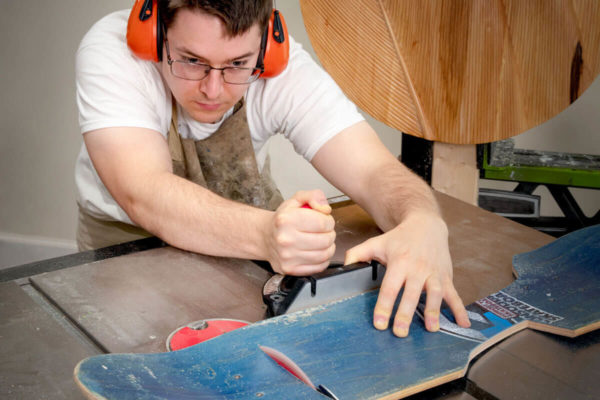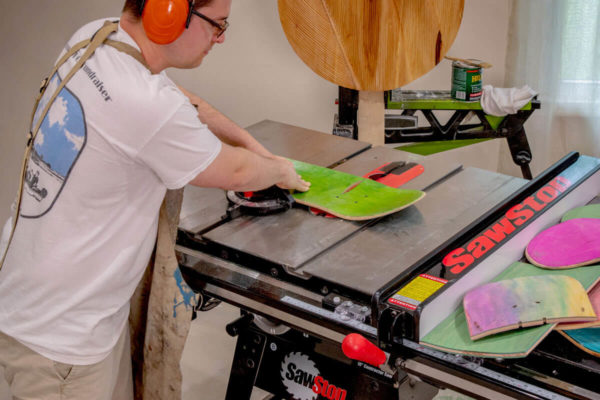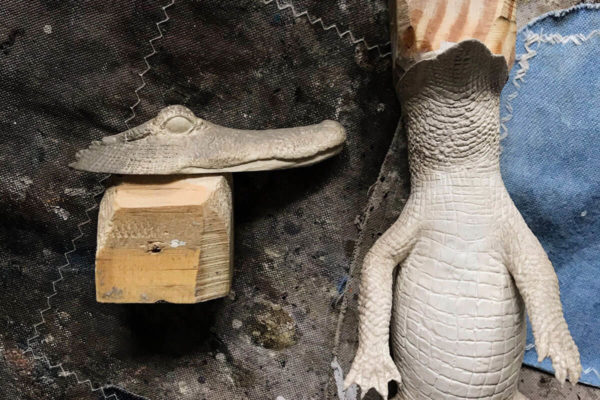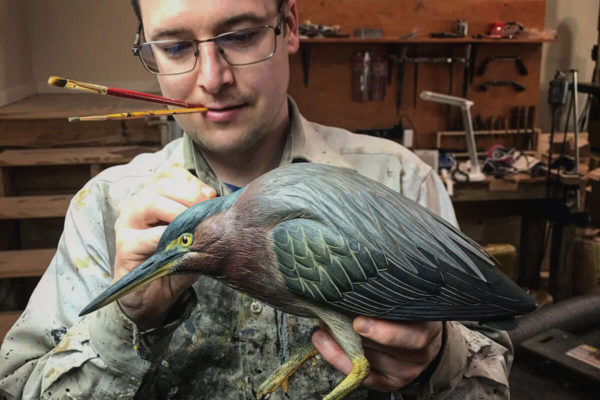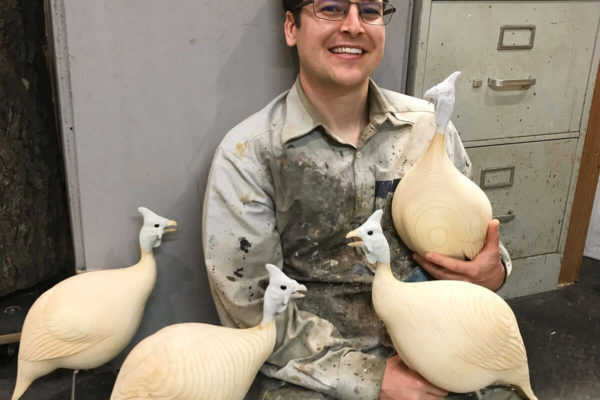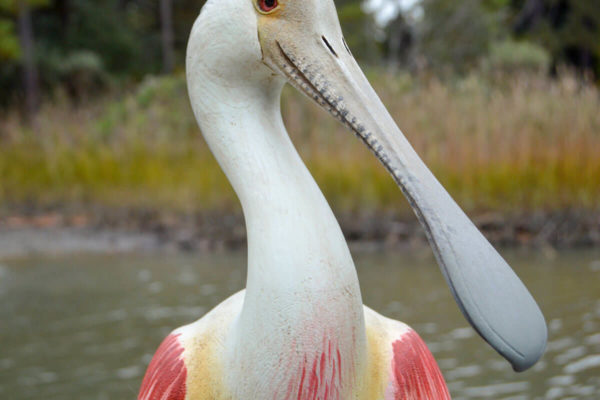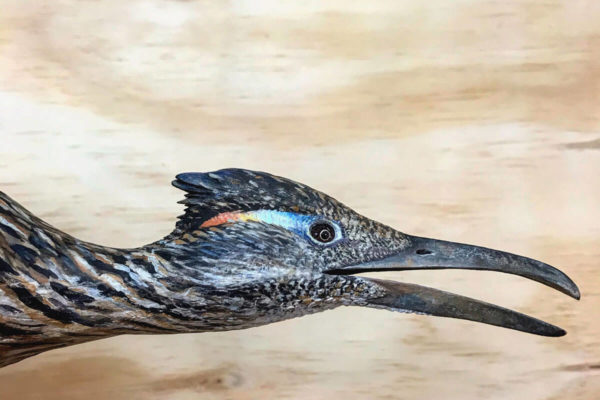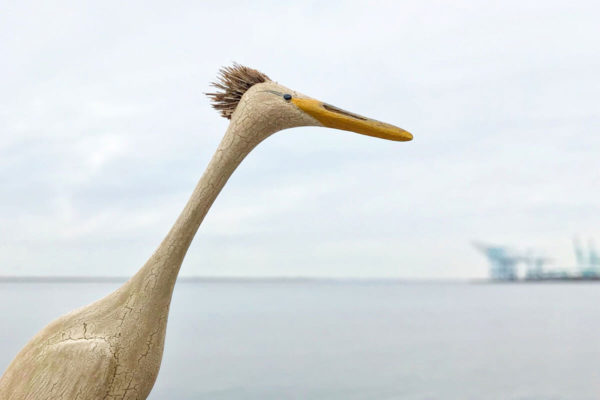The Contractor Saw Takes Flight – Q & A with Spencer Tinkham, Artist & SawStop Owner
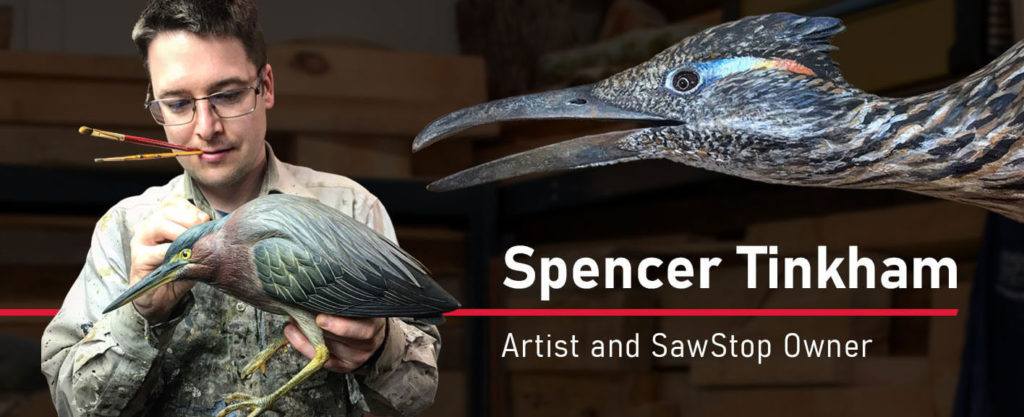
Reclaiming the Wild
His wood sculptures draw influence from literature, folk art, Modern art, and contemporary art.
Q&A with Spencer Tinkham
SS: How would you describe your work?
ST: Most people don’t realize that my work is made from wood. They think it’s ceramic or cast. I create wildlife out of found objects, mostly wood with a few metals. I finish most pieces with paint using oils and pigment powders. It’s like a chemistry experiment, I can achieve different finishes for different projects. If I want something washed out, weathered, cracked, or bright and intense, I can do it. And, oil is more durable and easier to control.
SS: How did you get started, and how did you learn?
ST: I got started when I was 8 years old. My grandfather gave me a pocketknife and together, we would whittle sticks on the back porch. He passed away from cancer shortly after and carving was a natural way to stay connected to him and the time we had together. When I was a kid, I would carve soap bars, firewood scraps, sticks; anything I could find. I carved a lot of animals. It was like getting a car when you’re 16 and finding a new sense of freedom and a whole new world.
If my house was on fire, I’d grab a piece from when I was a kid. Free of technical restraints, they have so much personality and fearlessness. They’re just pure. I love seeing what new artist make, especially young ones.
SS: What are you trying to accomplish with your work?
ST: I hope to get people excited about nature and conservation through my art. By making art out of reclaimed material I want to make the connection of the material to nature. I hope my art may encourage people to act, to do small things like pick up trash on the ground and put it in the recycling bin and be mindful about the environment.
SS: Some of your work is very stylized and other pieces are more realistic. Do you have a preference?
ST: I am better at sculpture than words, so I like to express myself in a variety of ways. With abstract you need to focus on form. With realism, you need to focus on the details. I think it’s important to bounce between both to be a better craftsman and artist. It pushes my skills.
SS: What is your creative process?
ST: My work is most often inspired by something I see. When I see a bird or a fish, or another animal do something crazy, I’ll sketch it down in about a minute. My notepads are everywhere: car, kitchen, shop, dining room, just everywhere. I try to draw immediately. Then, I will sketch out a larger piece later. I really want to capture the behavior of an animal, not just its likeness. And for me, it’s easier to give something personality and a unique voice if it is life size. As I hone the lifesize drawing, I look through my piles of materials and plan how they will be used in my sculpture.
SS: What is your favorite thing to do in your shop?
ST: I like that each day is different, but as it relates to the process of my work, I really like assembly; screwing stuff together, gluing it, nailing it. Putting stuff together is extremely rewarding. It’s like adult Lego. It’s a puzzle and a challenge, but it is exciting to see a piece enter that third dimension. And, I know when I put something together, it is not coming apart.
SS: What is the best way to find reclaimed material?
ST: Always be ready. I have the seats removed from my SUV in case I see something, I can stop and grab it. Dumpsters in general are great, especially at construction sites. Spaces that are undergoing a remodel are a treasure because solid material is being replaced for aesthetic reasons. Old beams, square nails, or old brass screws are items I love to reuse.
Shorelines are great because you can find random objects that have been touched be nature. Things that may not be old but are heavily weathered or distressed by the salt and the sea. Rusted metal rods and weathered beams and planks. I am drawn to objects with character and patina that could not be recreated without time and exposure to the elements.
Either as a tool to create texture or part of a sculpture, a found object can have many uses.
SS: What skill have you acquired that you’re most proud of?
ST: I do not have any formal art training and I started with a small knife, so painting was tough for me. Early on, my carving was so much better than my painting. I would just expect it to look worse after I painted a piece. But I wanted to master the painting process because the work did not feel complete without it. I did not want someone to see my work and think “That’s a wooden bird.” I want them to see it and say, “Hey, that’s a Guinea hen eating a bug”. I want the experience of the animal to shine through.
SS: What is the one tool you can’t live without?
ST: My pen and notepad. My ideas are everything and I start with a pen and note pad to capture them. I might not be the best at any given shop skill, but I consider my creativity a strength. The pen [in particular] forces me to keep drawing, consider, and iterate an idea. If I make a mistake with a pen, I redraw the whole thing again. Frequently, an idea will morph into a totally different concept. Without erasing each drawing, I am always able to see how a design developed. I often revisit my sketch books, rethink projects, and find new inspiration from my own work.
SS: Why do you use a SawStop saw?
ST: I chose the Contractor Saw because it is more powerful than the Jobsite Saw. I do not rip long lengths, but I do cut through thick pieces of softwoods. Even with the cast-iron wings, my saw is light enough to move around in my studio with ease. I have never felt like it was underpowered for my needs. The T-Glide fence on my Contractor Saw is very precise and is another reason why I chose this saw over the Jobsite Saw. The dust collection panel makes it easy to hook up my flex hose, and very little dust escapes from around my saw.
I’ve seen people after table saw injuries and my wife is a nurse. One injury would have paid for an entire shop full of tools.So, it was better to get the saw before I lost a finger or worse. Before having a table saw, squaring wood was exceedingly difficult. I was forced to make a piece into something less than I wanted because I could not shape it properly. Reclaimed material presents many challenges and I’m so glad to have a saw that works well for my projects and offers peace of mind.
SS: What advice would you give a new wood worker?
ST: Spend less time thinking and more time making. Avoid overthinking the process, doubting your abilities, or worries about removing too much material. You will make mistakes. I cannot think of a single piece I have made without making some error along the way. But making mistakes allows me to explore a repair or pivot the design. When you’re new to this, you don’t realize the value of a repair or pivoting to make the piece different. You can’t be afraid of the process. I messed up a lot. When I began making duck decoys, I would take them into the wild. With a live bird swimming next to my decoy I could see how poorly my paint looked. My first 30-40 decoys actually sank. It took years and a lot of failure. Many of my early attempts sit somewhere in the bottom of Chesapeake Bay, but I figured it out.
SS: How does your community/environment inform your work?
ST: Water is the most abundant ecosystem for life and I live on the Chesapeake Bay. There are lakes, freshwater and brackish rivers, and a variety of ecosystems. I don’t make sculptures of people. I focus on animals and nature centered themes. I’ve seen osprey making nest out of trash and whales washing up on shore. I can see the impact that people have on the environment. Originally, I did not use reclaimed material in my art, but eventually realized that the use of found material can support my work and make use of something that would have otherwise had an impact on the environment.
Make your next project on the Contractor Saw
#SawStop on Instagram to share your story or project
Photos
